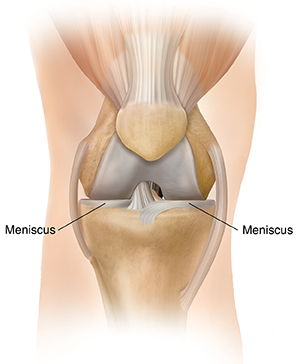A
B
C
D
E
F
G
H
I
J
K
L
M
N
O
P
Q
R
S
T
U
V
W
X
Y
Z
Click a letter to see a list of conditions beginning with that letter.
Click 'Topic Index' to return to the index for the current topic.
Click 'Library Index' to return to the listing of all topics.
Having Meniscal Transplant Surgery
Meniscal transplant surgery is a surgery to replace missing or damaged meniscus (cartilage) in the knee. The meniscus is replaced with one from a cadaver donor.

What to tell your healthcare provider
Tell your healthcare provider about all the medicines you take. This includes both prescription and over-the-counter medicines, such as ibuprofen. It also includes vitamins, herbs, and other supplements. And tell your healthcare provider if you:
-
Have had any recent changes in your health, such as an infection or fever
-
Are sensitive or allergic to any medicines, latex, tape, or anesthesia (local and general)
-
Are pregnant or think you may be pregnant
Tests before your surgery
Before your surgery, you may need imaging tests. These may include X-rays and MRI scan.
Getting ready for your surgery
Talk with your healthcare provider about how to get ready for your surgery. You may need to stop taking some medicines before the procedure, such as blood thinners and aspirin. If you smoke, you may need to stop before your surgery. Smoking can delay healing. Talk with your healthcare provider if you need help to stop smoking.
Also make sure to:
-
Ask a family member or friend to take you home from the hospital
-
Plan some changes at home to help you recover. You may need help at home. You’ll be using crutches for several weeks.
-
Follow any directions you are given for not eating or drinking before surgery
-
Follow all other instructions from your healthcare provider
You will be asked to sign a consent form that gives your permission to do the procedure. Read the form carefully. Ask questions if you have concerns or something is not clear.
On the day of your surgery
Your surgery will be done by an orthopedic surgeon. They will work with a team of specialized healthcare providers. The surgery can be done in several ways. Ask your surgeon about the details of your surgery. The whole procedure may take a couple of hours. In general, you can expect the following:
-
You may have general anesthesia, a medicine that allows you to comfortably sleep through the surgery. You will not be awake or feel any pain during the surgery. Another option is regional anesthesia. The area being operated on is numbed from pain and medicine (sedation) to make you relaxed and sleepy is given.
-
A healthcare provider will watch your vital signs, such as your heart rate, oxygen levels, breathing, and blood pressure during the surgery. If you get general anesthesia, a breathing tube may be put down your throat during the surgery to help you breathe.
-
You may be given antibiotics during and after the surgery. This is to help prevent infection.
-
After cleaning the affected area, the surgeon will make a small cut through the skin and muscle of your knee.
-
The surgeon puts a very small camera through this incision. This is used to help guide the surgery.
-
The surgeon removes any remaining meniscus with very small tools put through the incision.
-
The surgeon sews the donated meniscus into the joint space with stitches. Screws or other devices may be used to hold the meniscus in place.
-
The surgeon makes other repairs as needed.
-
The surgeon closes the layers of skin and muscle around your knee with stitches.
After your surgery
After the procedure, you'll be taken to the postanesthesia care unit (PACU) to be closely watched as you awake from the anesthesia. Your healthcare team will watch your vital signs, such as your heart rate, blood pressure, oxygen levels, and breathing. You’ll be given pain medicine if you need it.
Once you are awake and stable you may be able to go home or you may need to stay in the hospital overnight for observation. When it’s time to go home, you’ll need to have someone drive you.
Recovering at home
If you have some pain right after your surgery, you can take pain medicines. The pain should quickly start to get better. You will probably need to wear a knee brace for a few weeks. You might also need to use crutches during this time. You’ll be instructed on how you can move your knee and when you will be able to bear weight on your knee. You may need physical therapy for a few months. This is to help you keep your strength and range of motion. It may be several months before you can go back to all your normal activities.
Follow-up care
Make sure to keep all your follow-up appointments. This is so your healthcare provider can keep track of your progress. Follow all their instructions. This can help your chance for a good recovery.
When to call your healthcare provider
Call your healthcare provider or get medical care right away if you have any of these:
-
Fever of 100.4°F (38°C) or higher, or as advised by your healthcare provider
-
Chills
-
Redness, swelling, or fluid leaking from your incision site
-
Pain that’s getting worse
-
Loss of feeling in your leg or foot
-
Pain, swelling, or redness in your calf
Online Medical Reviewer:
Rahul Banerjee MD
Online Medical Reviewer:
Raymond Turley Jr PA-C
Online Medical Reviewer:
Rita Sather RN
Date Last Reviewed:
4/1/2024
© 2000-2025 The StayWell Company, LLC. All rights reserved. This information is not intended as a substitute for professional medical care. Always follow your healthcare professional's instructions.